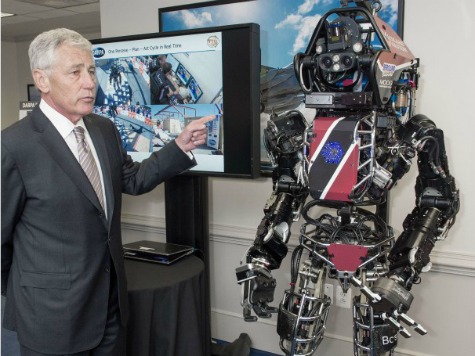US Defense Secretary Chuck Hagel got a first-hand look at a life-size robot that resembles Hollywood’s “Terminator,” the latest experiment by the Pentagon’s hi-tech researchers.
But unlike the cinematic version, the hulking Atlas robot is designed not as a warrior but as a humanitarian machine that would rescue victims in the rubble of a natural disaster, officials said on Tuesday.
The 6-foot-2-inch (187 centimeters) Atlas is one of the entrants in a contest designed to produce a man-like life-saver machine, the brainchild of the Defense Advanced Research Projects Agency (DARPA).
The competition, which will require the bots to navigate rough terrain and enter buildings, was created in the aftermath of Japan’s Fukushima quake and tsunami disasters.
DARPA, the Pentagon’s research arm known for futuristic projects often evoking science fiction, showed off the Atlas robot to Hagel, but except for LED lighting, the humanoid was apparently switched off on a “static” display.
Brad Tousley, head of DARPA’s Tactical Technology Office, told Hagel that Hollywood has created unrealistic expectations of what real robots can do.
Building robots that can climb ladders, open doors and carry objects requires daunting feats of engineering and computer science, he said.
Scientists also showed Hagel the latest technology for prosthetics, including a mechanical hand that responds to brain impulses and a prosthetic arm controled by foot movements.
A wounded veteran who once worked with Hagel in the 1980s demonstrated one of the devices, giving the Pentagon chief a thumbs up with his prosthetic left arm.
He controled the device using two accelerometers strapped to his feet, manipulating the elbow, wrist and fingers.
Hagel hugged Downs and shook his mechanical hand.
Hagel said the new technology would have a dramatic effect on the lives of wounded soldiers.
Justin Sanchez, a medical doctor and program manager at DARPA who works with prosthetics and brain-related technology, showed Hagel a video of a patient whose brain had been implanted with a sensor, allowing her to control a mechanical arm with her thoughts.
Scientists then displayed a shiny black mechanical hand and arm that responds to brain impulses, and said sensors would be attached to allow the fingers to send sensations back to the brain.
The tactile feedback system should be operational within a few months, officials said.
DARPA managers showed Hagel other technologies, but reporters were ushered out after the first three demonstrations due to concerns about revealing military secrets.
A US defense official who spoke on condition of anonymity said Hagel was given an update on “PLAN X,” a cyber warfare project, a system to link tactical air controllers using tablets and a new long-range anti-ship missile that would be less dependent on global navigation systems.

COMMENTS
Please let us know if you're having issues with commenting.